
Kenny Scharf reenacting his emoji-like paintings’ emotions with ‘Scardey’ (above his head) and ‘Tribali’ on his side
American artist Kenny Scharf’s work straddles a line between pop-art, street art and neo-expressionism. Through surreal imagery and humour, he challenges the elitist boundaries of fine art. Granted exclusive access to his new LA studio, LUX editor-at-large and artist Maryam Eisler spoke to Scharf about cosmic donuts, emojis and his friendship with Keith Haring.
Photography by Maryam Eisler
Maryam Eisler: You posted on your Instagram page that you found the black hole (referring to your image of a donut suspended in space) long before the black hole was photographed! Tell me about that.
Kenny Scharf: Well, I’ve been making cosmic donuts for quite some time now. I was always intrigued by this theory that the universe was shaped like a donut. I love the way donuts look….so it seemed so natural to do donuts in space! So when I saw the new blackhole image, I said ‘Uhhhh that looks like a donut!!’ I couldn’t help it.
Maryam Eisler: So I cannot help but ask you the question: where do we end up? In the donut’s hole or do we keep sparkling like its sprinkles?
Kenny Scharf: I don’t really know…maybe it’s even more sparkly in the hole!
Follow LUX on Instagram: the.official.lux.magazine
Maryam Eisler: Would it be fair to say that you invented the emoji?
Kenny Scharf: I guess I did. I’ve been doing it [referring to the round paintings] for 40 years before the actual internet came about.
Maryam Eisler: So copyright on the emoji?
Kenny Scharf: Yeah I need to get a penny every time someone uses those emojis. Actually I have my own emojis app. It costs two dollars!
Maryam Eisler: You’ve never been about definition, have you? And pretty much spanned across all mediums…
Kenny Scharf: I’m always wanting to break boundaries. If there’s a border, I’m going to go outside of it. You can’t keep me in. That’s against my…everything!

A view into the mezzanine of Kenny Scharf’s LA studio space
Maryam Eisler: Talk to me about New York in the 80s and the confluence of art, fashion, music, and the night clubs.
Kenny Scharf: When I moved to New York in the late 70s, there weren’t a lot of places artists could show their work or even make their work. There were so many young kids like myself who moved to New York with ambition. There were musicians and writers and people in fashion too. So nightclubs were a great venue to do your thing. Not only were nightclubs a place where you could make and show art, but they were also our livelihood. So we worked a couple nights a week and that was all you needed to pay your bills for the whole week, and you were then free to make your art. So New York became a place where you could move to, as a young artist without money, and find your way and meet other artists. It was this whole community that was just there. I feel very lucky that I arrived at that moment in time. But, I think the nostalgia for the 80s is more about the late 70s’. Because by ‘82, people started dying. I was just in my 20s and I was spending most of the latter part of the 80s going to hospitals and funerals and saying goodbye to friends and people. It was just beyond a nightmare.
Maryam Eisler: From Studio 54 to Club 57, tell me about it.
Kenny Scharf: Studio 54, I only went into once. Everyone knows it was a famous disco, a happening place. But my kind of group was more Punk-rock, New-Wave, downtown and very anti-uptown.
Read more: Artist Sassan Behnam-Bakhtiar on the rise of interest in Iranian art
Maryam Eisler: East Village right?
Kenny Scharf: Yeah. At that time, Manhattan was very different with different parts to it. We hardly ever went north of 14th street, and the uptown people never ventured down to our neighbourhood. Club 57 was an amazing place and it did get its spotlight recently. There was a show at the MoMA that highlighted it. It was just this kind of moment. I don’t know if that kind of gathering place exists anymore, now that everything is online and internet-based. It almost harkened back to Berlin or Paris before the war and to these moments where artists got together and created with and for each other, always testing new ideas.
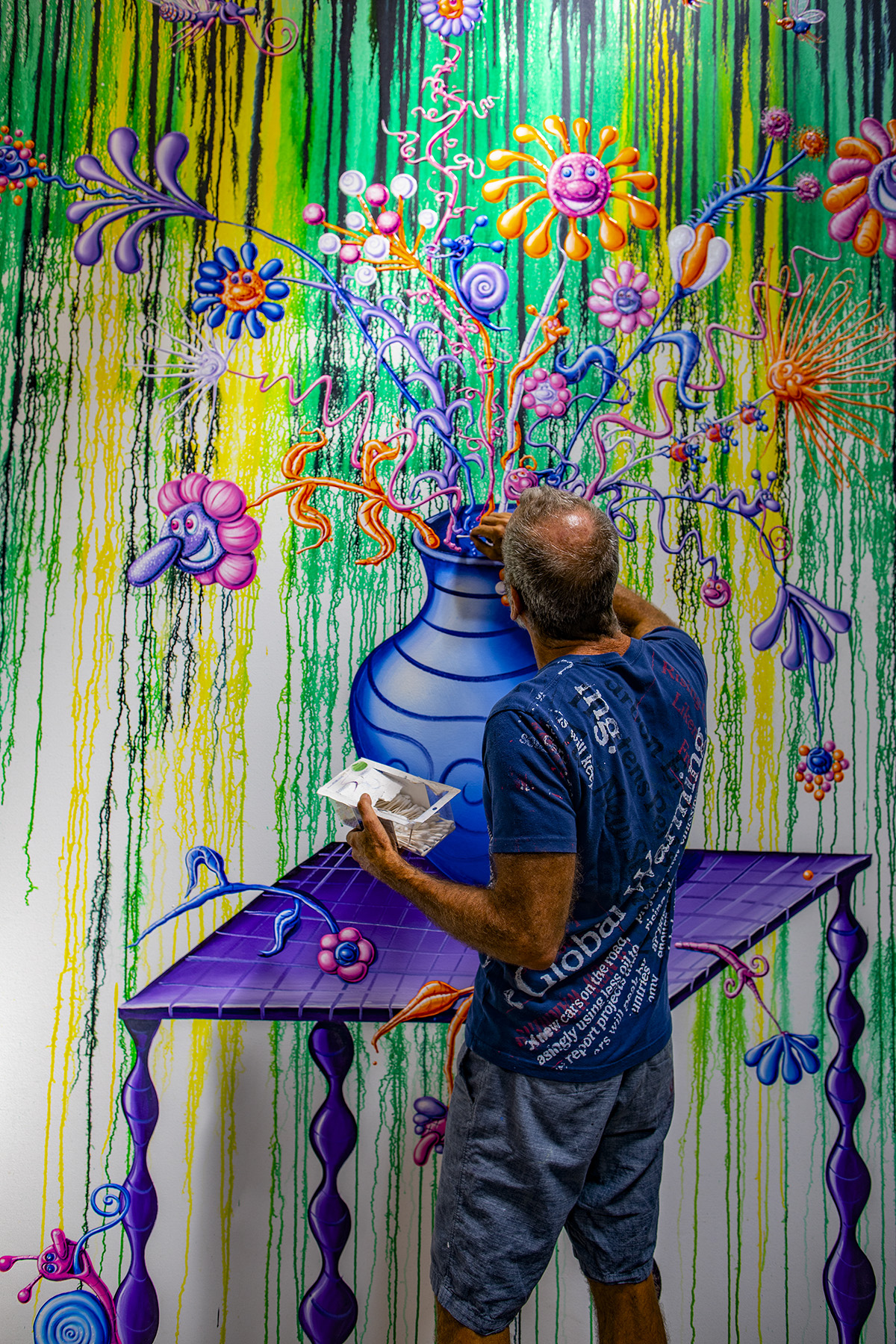
Kenny adding his final touch to an untitled painting depicting a flower arrangement
Maryam Eisler: A form of inner salon of some sort?
Kenny Scharf: Exactly. And the thing that was so good in retrospect, even though we were all dying to be famous and whatnot, was that we had each other to test out whatever we wanted to do. It was very inspiring. You were able to do whatever you wanted to do in the safety of this audience before you went out into the big world. A chance to incubate ideas.
Maryam Eisler: Would that idea of safety and sanctuary translate into your own Cosmic Taverns?
Kenny Scharf: Yes, that idea is definitely about safety and sanctuary. In fact, the very first one I did was around ‘82 and I was living in an old ramshackle townhouse in the middle of Times Square. Keith Haring was my roommate. It was on 6th Avenue and 42nd street. There was so much madness on the street surrounding us that I would create these environments inside, using artificial things – mostly plastic garbage and appliances and stuff which I would find on the street. And I would create this very chaotic artificial environment that actually acted as a refuge. Let’s call it artificial nature for urbanites!
Maryam Eisler: The idea carries on today. I see it here in your studio. It seems like you still work with found objects, recycled plastic and disused garbage ….
Kenny Scharf: I’m obsessed. I’ve been obsessed with garbage all my life. When I first moved to New York in the late 70s, the whole city was garbage. Nobody was picking it up. Everything I needed for my new life was there on the streets: I found my furniture, my clothes. This whole New Wave scene … we were all wearing 50s clothes because we all found them in the garbage! I feel like trash is such an indicator of the society that we live in. Not only does it show a lot about who we are, but I love the idea that these objects were actually used by somebody, and that they have this whole story and life that I don’t know about. And of course, there’s also recycling and the fact that we are drowning in our own garbage!

A view into the ground floor of Scharf’s studio
Maryam Eisler: From garbage to accessible artistic content, philosophically speaking?
Kenny Scharf: Yes. Philosophically, I’ve always been a proponent of accessibility. When I moved to New York in the late 70s, Conceptual and Minimal art were in fashion. I just didn’t like it. It felt too elitist and I don’t want to be elitist. I’m always staggering this fine line because I want to be in museums, that upper echelon of where art is shown, but I don’t like the idea of alienating anyone either. And I mean Joe Blow on the street who may have never read art history or gone into a single museum before! I would like to get those people interested in art and maybe inspire someone with an uplifting message. My language is the language of art so I don’t want to turn off the art-educated either!
Read more: Why you need to see the Luc Tuymans exhibition at Palazzo Grassi
Maryam Eisler: Isn’t art, at the end of the day, about interaction and connection?
Kenny Scharf: Yes, and communication. I have a message. You have a show in a major museum and you are going to get a certain amount of people to go and see it. You do a mural in a high traffic spot on the street, and you’ll get the same number of people, if not more, seeing it every day. I also love the idea that art goes beyond boundaries. Most people think that art belongs on a wall in a gallery or a museum. I think it should be everywhere. I often like to think about ancient civilisations, the Greeks and the Egyptians, and how they infused art into their everyday objects the same way I do. I really believe that by doing this, you elevate your daily existence.
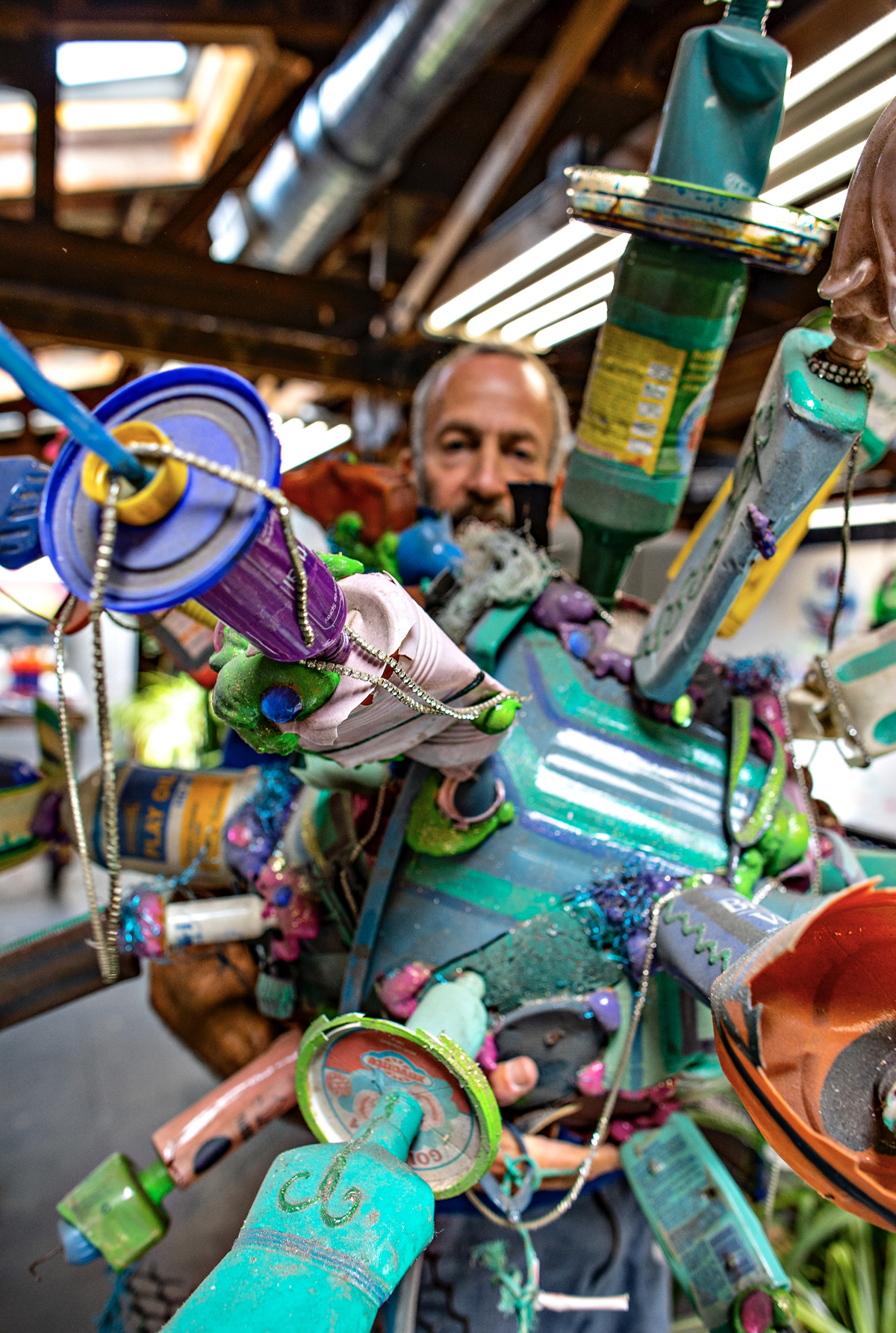
‘I’ve been obsessed with garbage all my life!’
Maryam Eisler: Your emojis are a form of hieroglyphic art, right? Image after image, you try to describe a state of mind, an emotion, a space, a place …. There’s an emotive aspect to your art.
Kenny Scharf: Yes. Communication, feelings, history… Art that I love is art that emotionally gets to me, and I want to convey the same thing to people. I want people to feel.
Maryam Eisler: I love your lack of concern about the monetary value of your art in a world dominated by the $ sign . You paint cars and give them away as long as they’re not resold for gain!
Kenny Scharf: Yes, I’ve done 250 cars. We take pictures. People have crossed the line only two or three times in the past. Not cool.

One of Scharf’s 250 painted cars, utilitarian artworks which he creates for free, with the promise that they are never to be sold for gain
Maryam Eisler: From Cosmic Taverns to Flintstone’s cavern. Where did it all start?
Kenny Scharf: The Jetsons and the Flintstones? Back in the early 80s, when I was trying to figure out how to get myself out there, I realised nobody in the gallery world was going to be interested in me if I just told them ‘Hey I make art! Come and see.’ My whole group was in the street and we met all these graffiti artists with incredible paintings on subway cars; they used the whole city as their canvas basically. Around the Times Square show in ‘81, a lot of downtown, Punk, New Wave art-types like myself, met with all the uptown Bronx graffiti artists, and there was this very interesting cultural mix moment. I had a studio at PS1 and I lived in the East Village so I used to ride my bike at two in the morning down from the 59th street bridge to the East Village and bomb the walls the whole way down. I thought that I wanted to do something that was very personal to me in many ways, the Flintstones! Not only because I grew up with them but because conceptually I love the idea of the Flintstones representing the past and the Jetsons representing the future. And everybody knows who they are. I wanted to do something that people already connected with but that was also part of me. And at one point, the past and the future collided and created mutants which were my own characters.
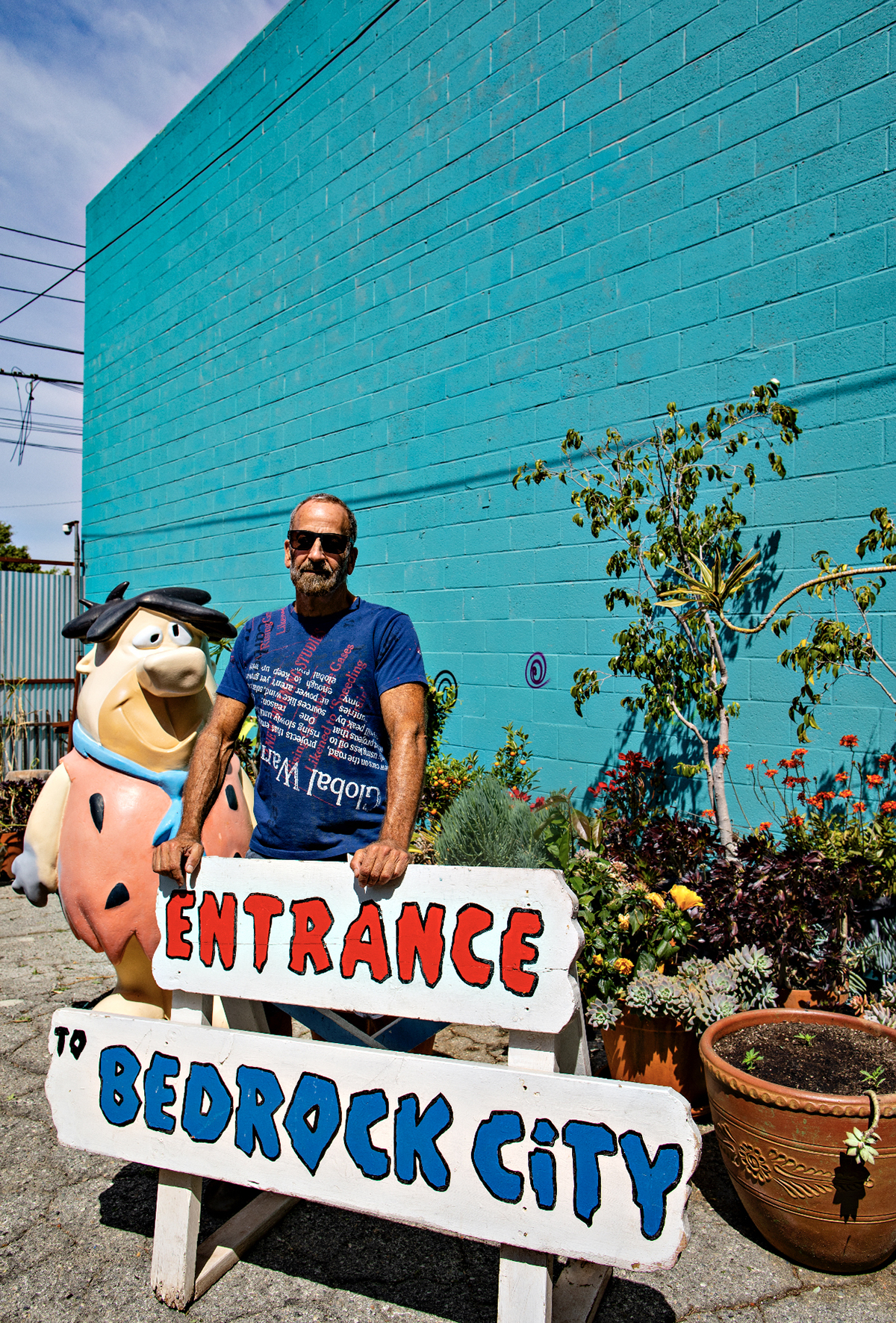
‘Conceptually I love the idea of the Flintstones representing the past and the Jetsons representing the future. And at one point, the past and the future collided and created mutants which were my own characters.’
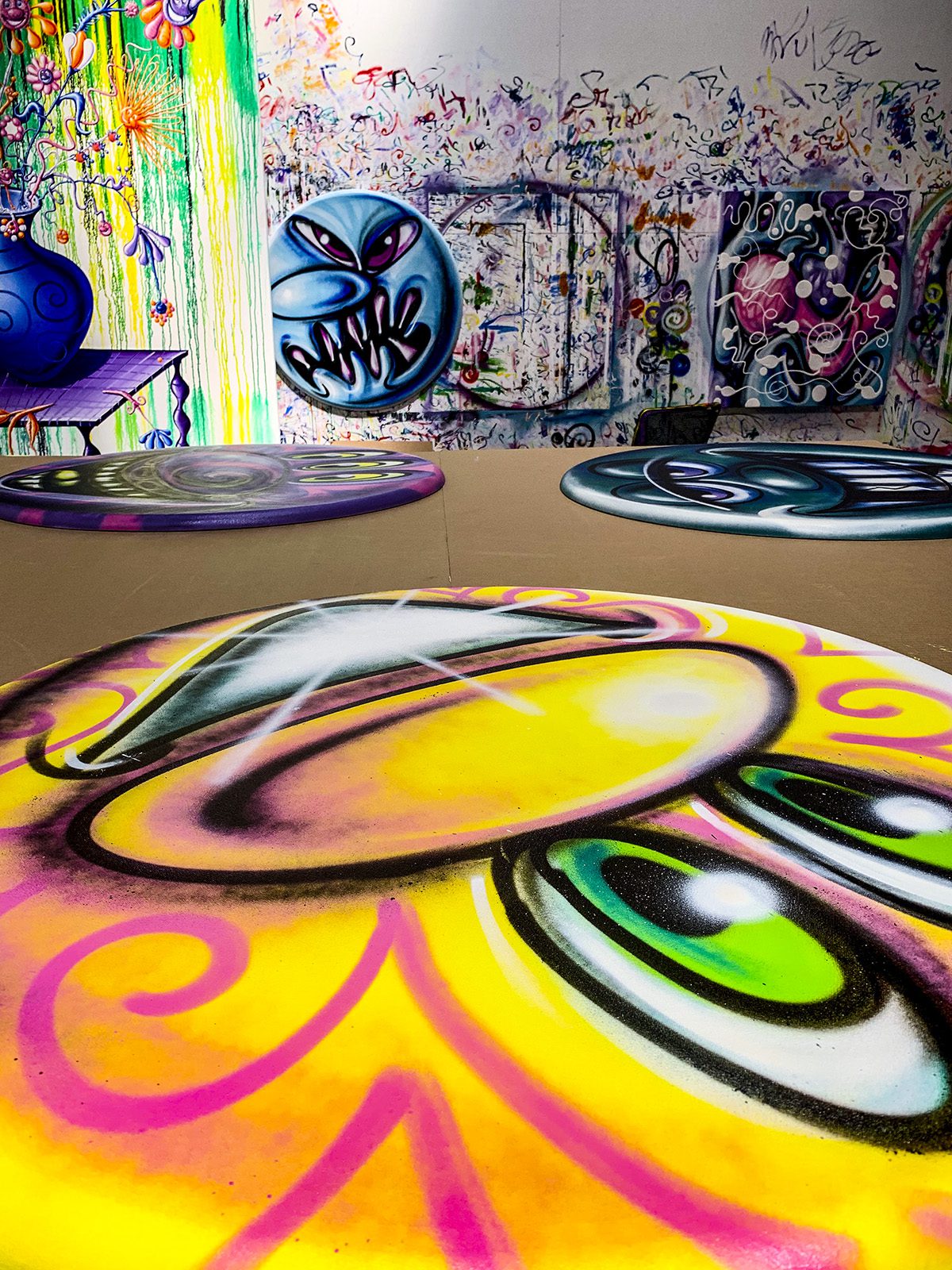
Maryam Eisler: So I haven’t brought up Keith Haring and Jean Michel Basquiat purposefully. Could you give me one word, one anecdote or a wonderful memory for each?
Kenny Scharf: I mean I have so many memories. I met Keith and Jean Michel in 1978, basically my second week of arrival from LA to New York. And we all had this instant connection. It’s like when you meet somebody and you don’t really know why you are so attracted to them and vice versa. I met Jean Michel and introduced him to Keith. The three of us were a little bit of a posse. I used to go around with Jean Michel and Keith and draw and paint on the street. One of my first memories was when I went to this apartment where Jean Michel was living; it was just about a block away from where I was living, and I saw these collages he had on the wall and I was just blown away. I swear I almost fell on the floor. It was one of those moments when you see something and there is so much energy coming off this piece of paper that it literally floored me. I’ll never forget that moment.
Maryam Eisler: Can you share your last memory with Jean Michel?
Kenny Scharf: Of course. With Jean Michel, our relationship was not easy. It started off very close and then he kind of turned on me. We had this very volatile relationship where I didn’t know which Jean Michel I was going to get on any particular day, and actually, it was the source of a lot of stress for me. I really cared for him a lot, and he could be really difficult. So in the late 80s, all that amazing explosion from the early 80s, had a little backlash where that kind of expression was not ‘the thing’ any longer and Jean Michel, as always, really took everything to heart and he was just really down. There was this moment where I remember connecting with him on the street, where he could look at me not as competition and an enemy anymore and realise that we were both on the same side of the line; he let down the guard. We had this special moment. I didn’t know he was about to die.
Maryam Eisler: I read the book The Widow Basquiat. It seems like he did that uncertain thing to everyone?
Kenny Scharf: He did it to the ones he cared about. He was always testing. He was really…very…disturbed. He really was.
Maryam Eisler: A sign of artistic genius, perhaps?
Kenny Scharf: Yes, I know.
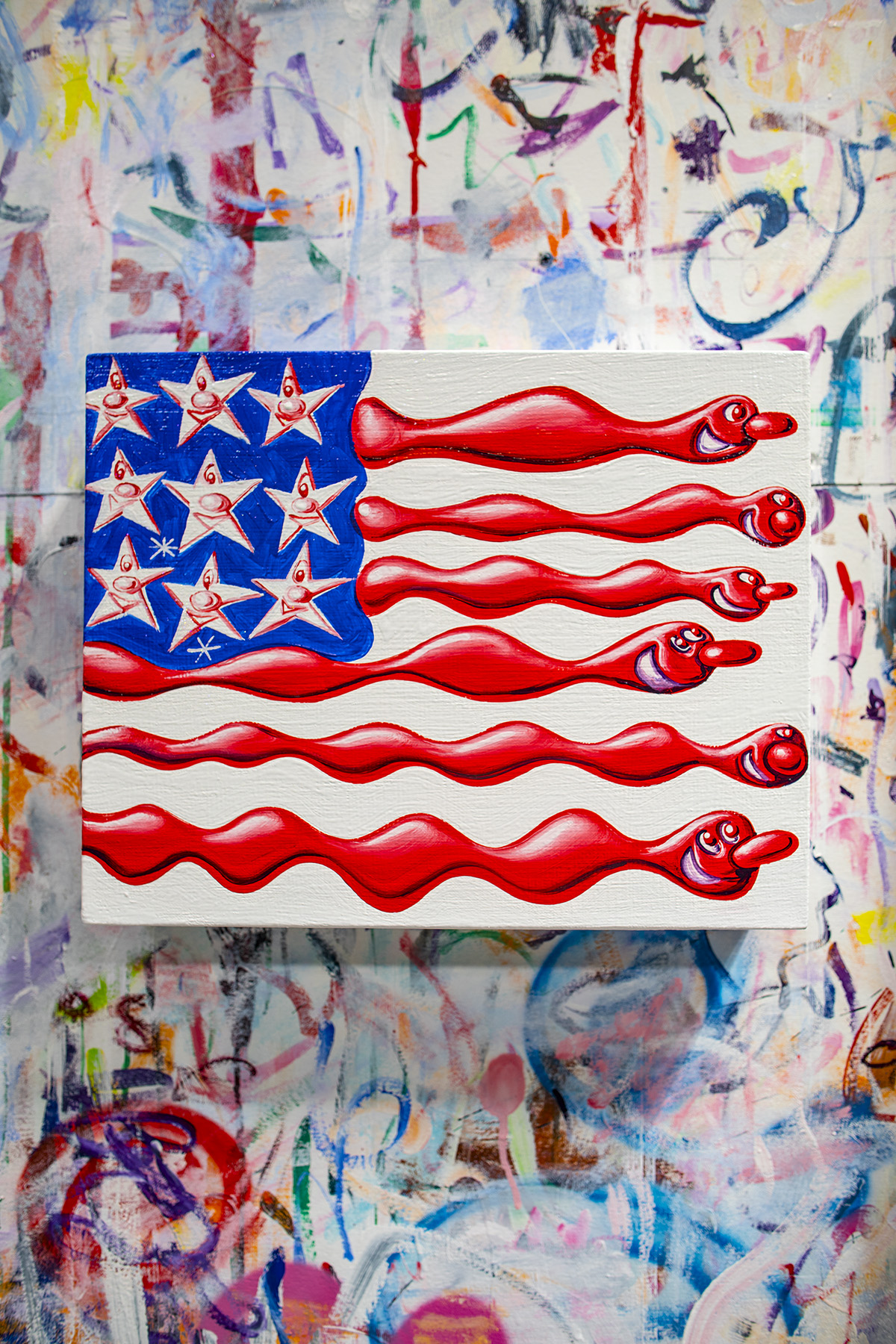
Untitled 2019 by Kenny Scharf
Maryam Eisler: What was your last memory with [Andy] Warhol?
Kenny Scharf: Right before he went in for the gallbladder surgery, I remember having a similar thing as I did with Basquiat – not that we ever had any down times because Andy was always great to me. He was always very supportive. But I remember…I dunno maybe he wasn’t feeling well or something. I remember I was in a restaurant and there was an emotional connection where I really felt something strong with him. Then I went to Brazil a week later and actually Keith [Haring] was with me when we found out about his death.
Maryam Eisler: And lastly, with Keith?
Kenny Scharf: I was the last person to be with him. So I was sitting with him and he wasn’t able to talk anymore. There’s no way I cannot cry, talking about my last moments with him. He was very agitated and I just told him ‘I know you can hear me’; I also told him that he should just calm down and relax because I was with him. And as his body relaxed, I said ‘You know you’re going to live on forever.’ I was telling him everything I believed and felt….It was really hard…losing my best friend.
Maryam Eisler: For you personally, to perform the act of creation, do you have to be at an emotional high or low? Are you really that happy-faced person?
Kenny Scharf: Sometimes. All the emotions, I am. I am a happy person. I’m an optimist despite a million things that are freaking me out. My feeling is that if I’m not an optimist, then I will kill myself. So I force myself to be optimistic no matter how I may be feeling inside. I take the stance and I do it. Because I’m here and I want to make the best of it. Now, I have grandkids and I’m really freaked out about the world they’re inheriting, so I have no choice but to be an optimist for them.
Maryam Eisler: Speaking of the world, one word on Trump?
Kenny Scharf: Piece of shit. Or just shit. Everything about what he represents is the antithesis of everything that I believe in. I’ve always felt that way all the way back to the 80s. I actually met him ten years ago, and I was so freaked out by his lack of normal decent connection. He was just so creepy. The whole thing nauseated me so much. The day of the election I couldn’t stop crying. I cried for a week. It was devastating and here we are two years later, and I still cannot believe this has happened. His name and the word President do not go hand in hand.
Maryam Eisler: You are now back in LA , your ‘home’? You left the concrete for greener pastures and blue skies, with a much more laid back attitude and even more space? And, of course, your family.
Kenny Scharf: I love it here. I was bouncing back and forth between LA and New York but when my grandson was born I realised that I didn’t want to be away anymore. I am completely in love with my grandkids. Obsessed in fact. I never realised how great being a grandpa was actually going to be.
Kenny Scharf’s solo exhibition ‘blue blood’ runs from 2 May to 28 July 2019 at the David Totah gallery, New York City
Discover Kenny Scharf’s portfolio: kennyscharf.com






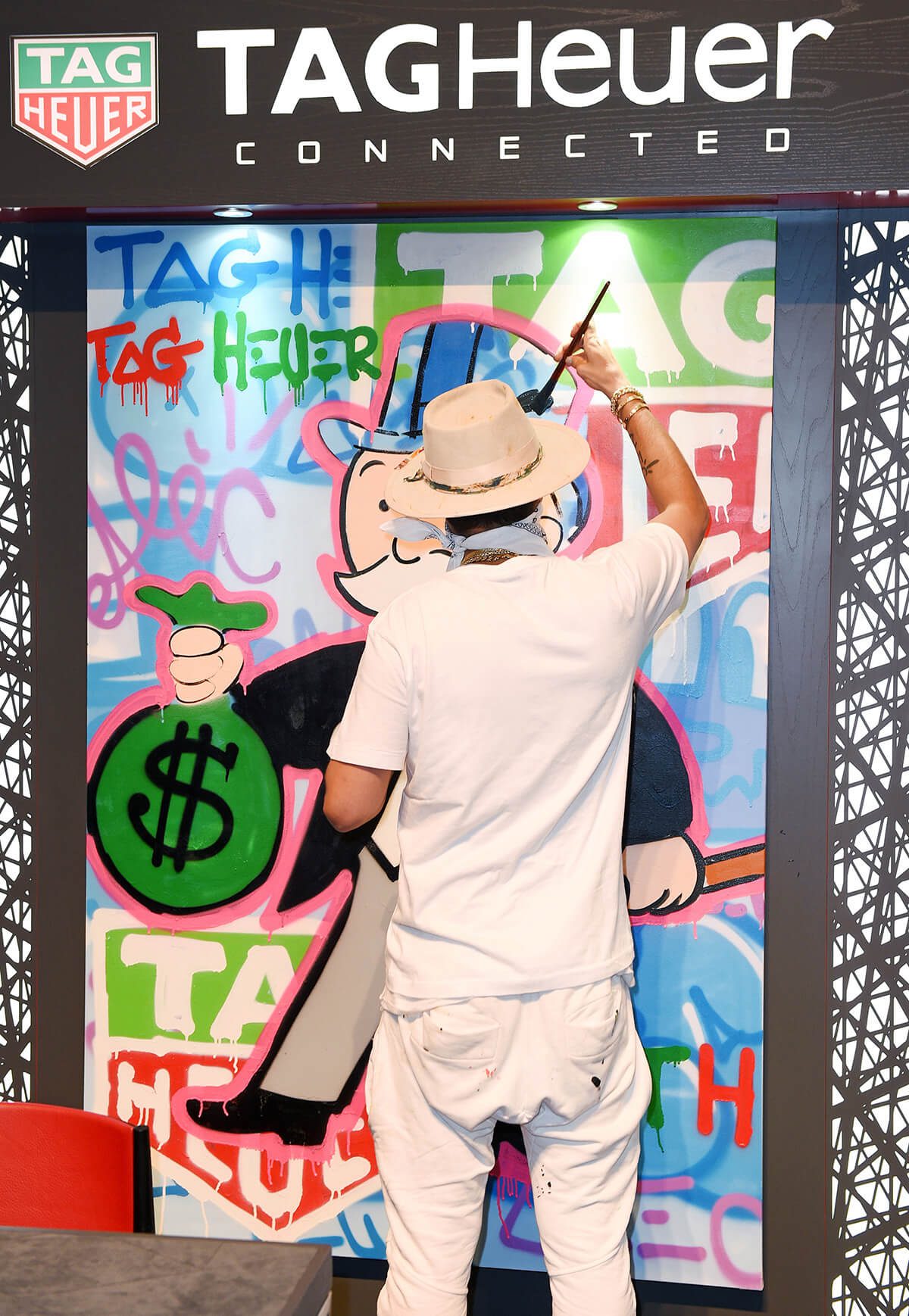
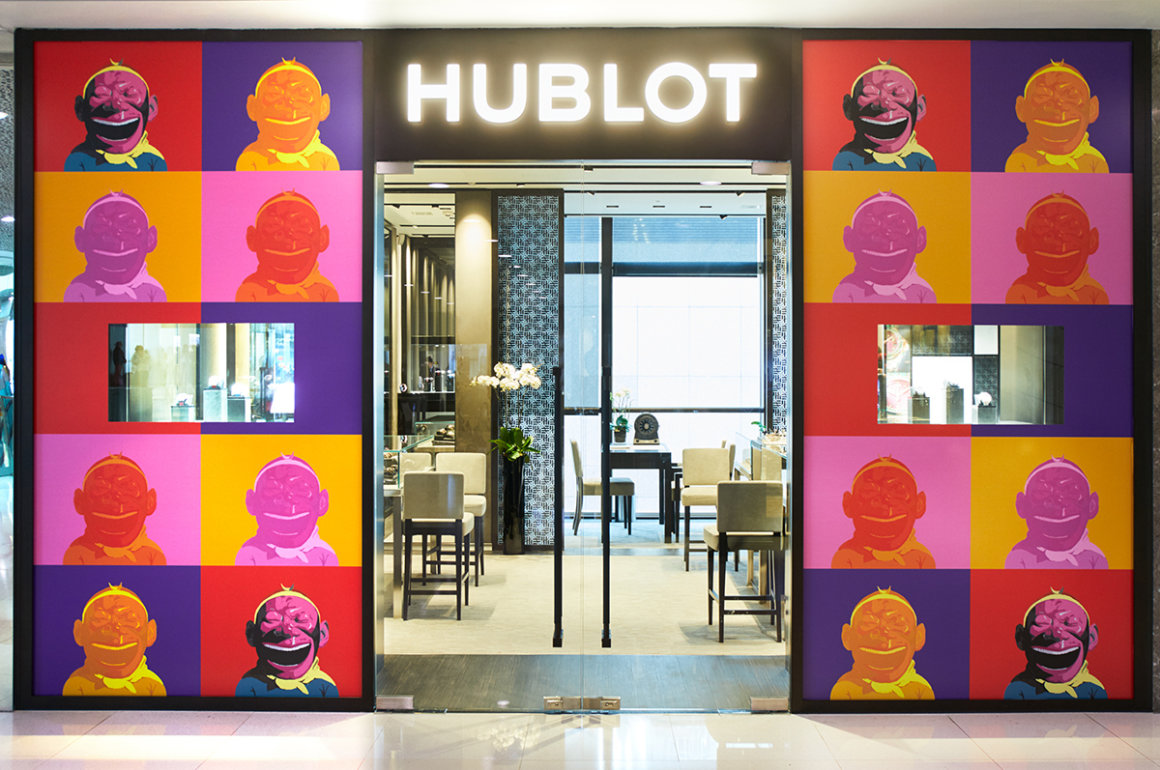
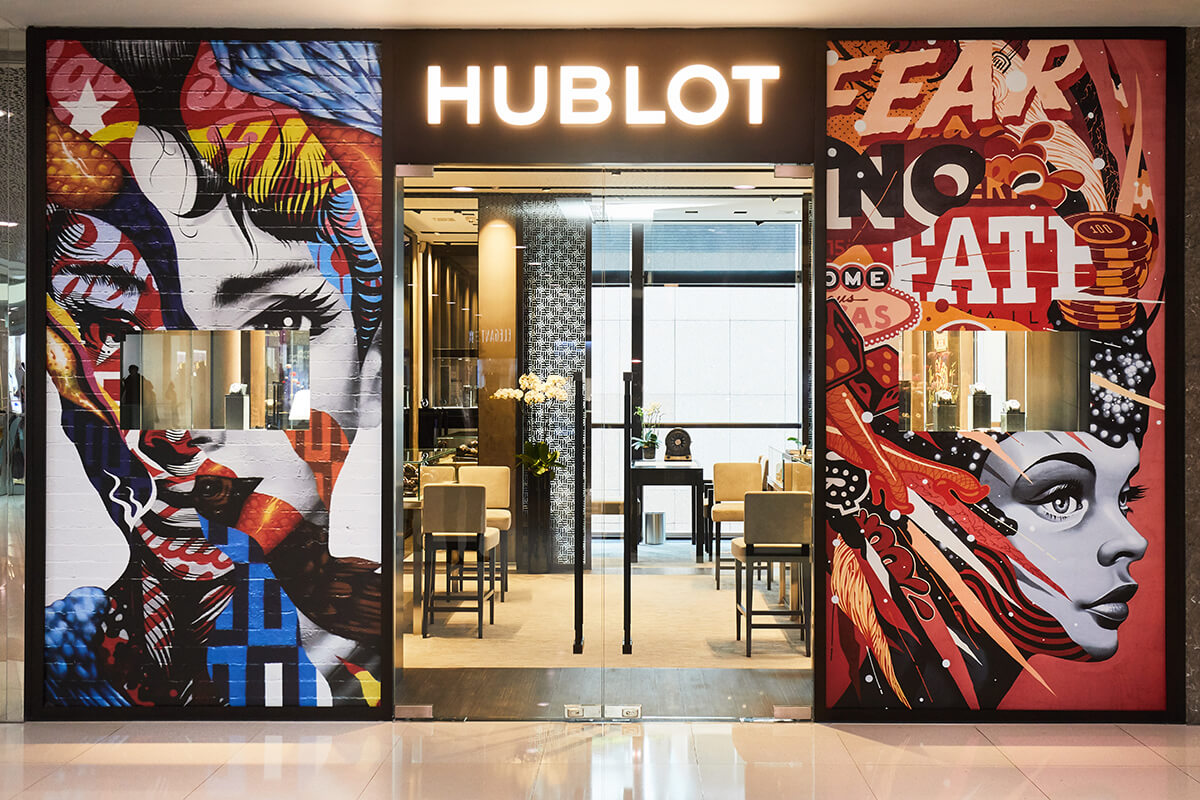
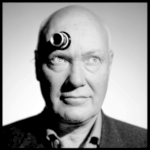






Recent Comments